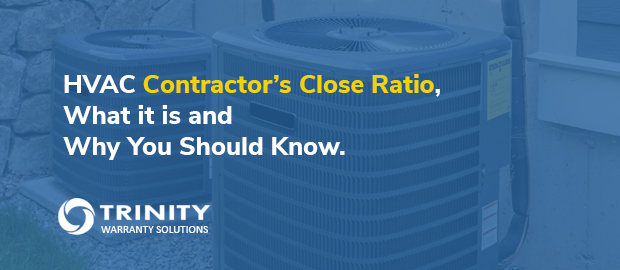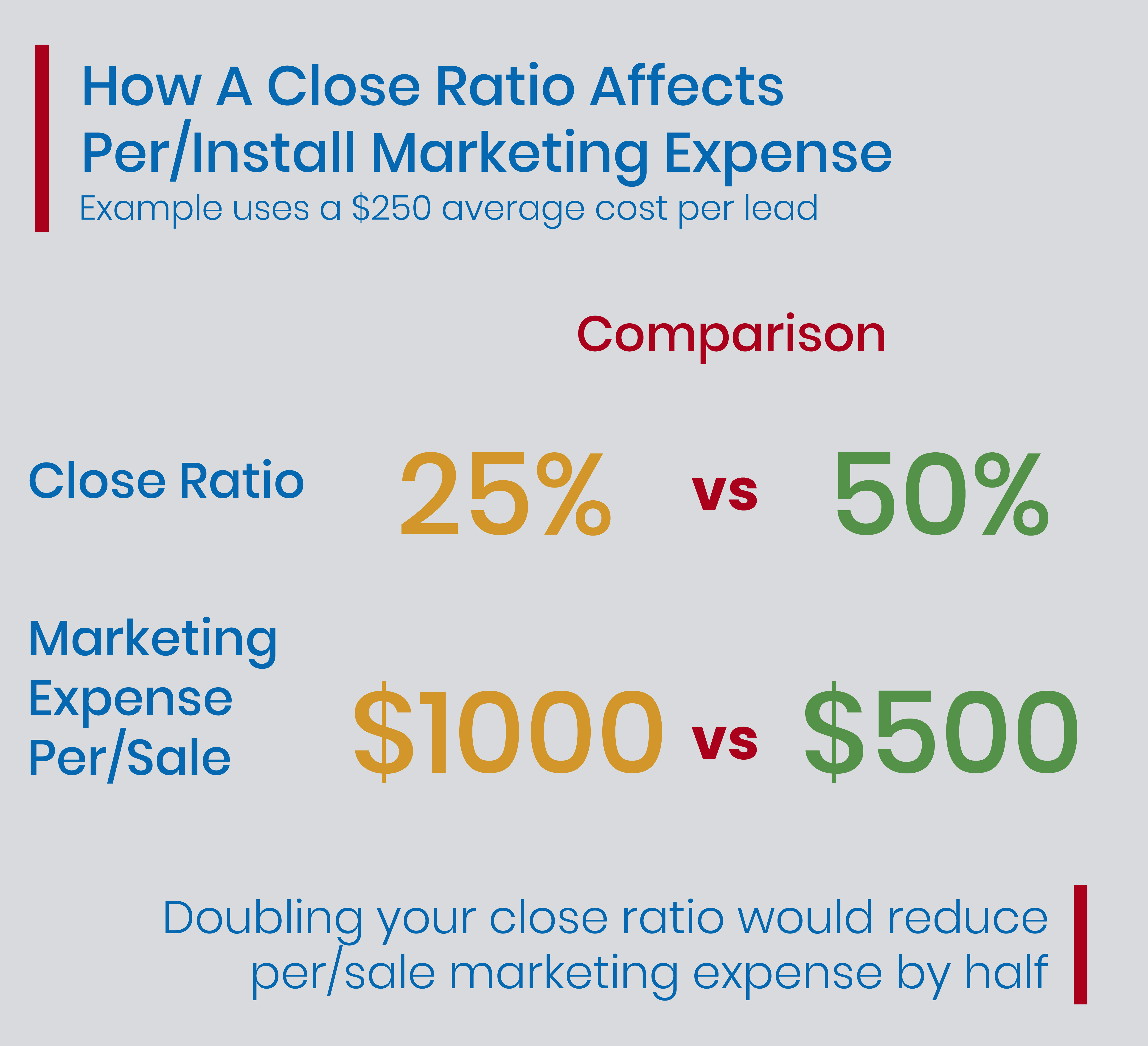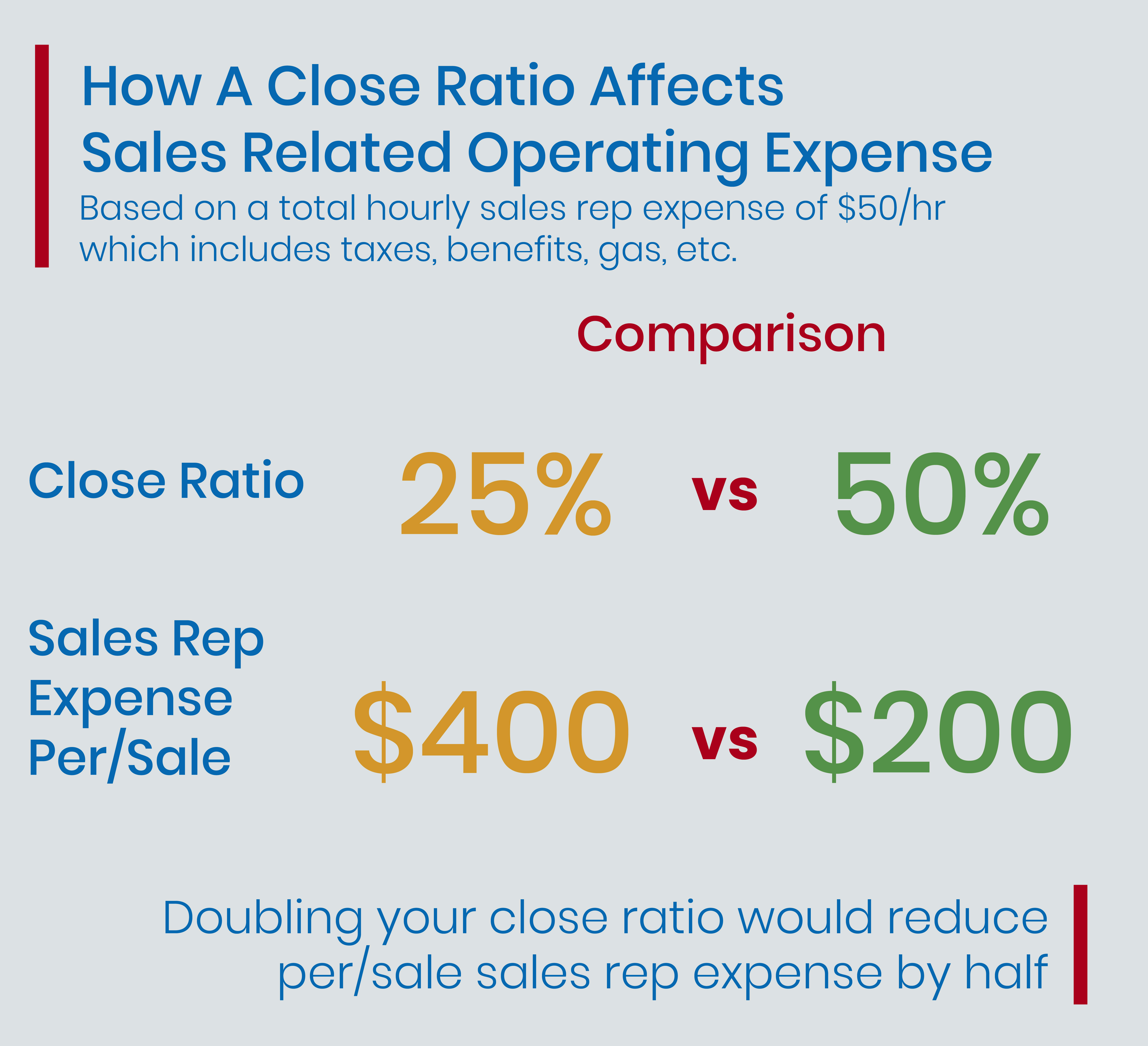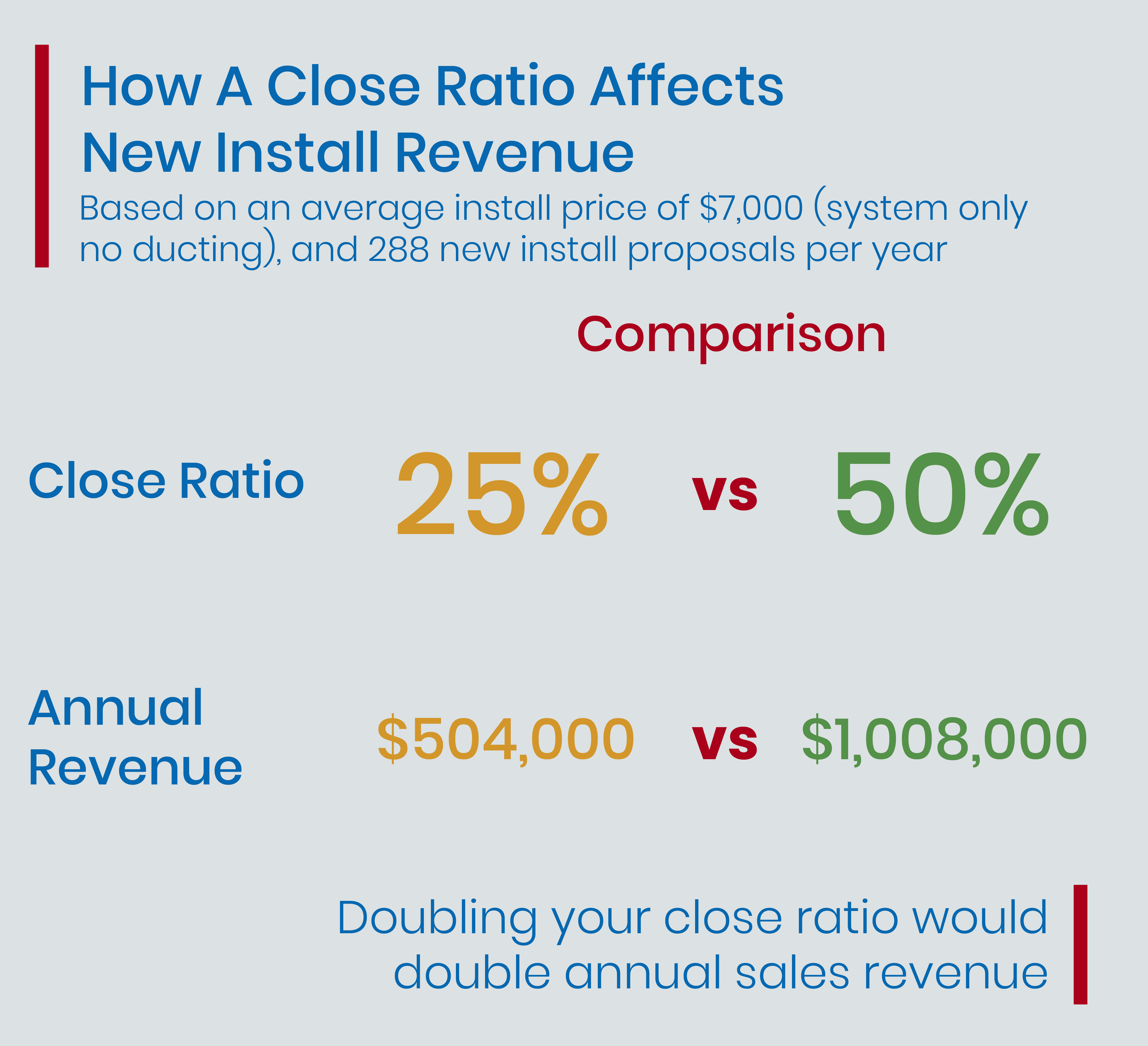ESAs extend the manufacturer's warranty on expensive HVAC / R / plumbing equipment, and protect against unexpected and untimely costly repairs. We can cover all brands and types of equipment.
Read more
Extended Warranty




The close ratio measures the number of proposals against sales that have been closed. The importance of this ratio should not be understated. There are many factors that contribute to this ratio. Knowing what those factors are is key to improving your sales to close ratio.
The close ratio takes the number of closed sales and divides that number by the number of proposals. Let’s take the example of new residential system installs. If in 1 month you write 24 proposals and out of those 24 proposals 6 turn into closed sales your close ratio is 25% (6/24 x 100). This ratio measures how efficient your business is at sales. Improving this ratio will play a big role in improving your bottom line. It has a significant affect in both the expense and the revenue side of the bottom line.
Close ratio has a significant affect in both the expense and the revenue side of the bottom line
To get a better understand how close ratios affect expenses we will compare a 25% close ratio to a 50% close ratio and see how that affects marketing & operating expenses of a HVAC contractor’s business
HVAC contractors can spend a considerable amount of money to keep the phone ringing with new business. Average cost per lead for a HVAC contractor is between $250 & $300 according to ACCA estimates, we will use $250 in this example. Let’s assume a contractor wrote 24 new install proposals in 1 month and all 24 of those proposals were a result of purchased leads. At $250 a lead the total cost to write 24 proposals is $6,000 with a 25% close ratio, $6,000 would generate 6 sales at a cost per new install of $1,000.
If the close rate doubles, the marketing cost per sale is cut in half
Taking the same example and changing the close ratio to 50%, that same $6,000 dollars would still buy 24 leads that would turn into 24 proposals the difference is the cost per sale. At a 50% close rate, the same amount of leads would generate 12 sales which would bring the cost per new install to $500. If the close rate doubles, the marketing cost per sale is cut in half.

Every proposal that is written costs money. HVAC contractors needs to pay a HVAC sales rep to drive to the home, inspect and assess the homeowner’s needs, understand the homeowner’s need and then build a quote. For the sake of this example, let’s assume this process takes 2 hours. We will also assume the sales rep is being paid the average salary of $33 an hour, and add employer paid tax, other benefits, and the cost of gas/tolls/car maintenance etc. to that amount. We will estimate the hourly cost to be $50. If it takes 2 hours per proposal the cost to write a proposal is $100.
Writing 24 proposals would cost a contractor $2,400, with a close ratio of 25% it would cost $400 per sale. If the close ratio was 50% the per sale cost would be $200.

We will continue with the example used above. If a contractor wrote 24 proposals and his close ratio is 25%, then at an average install price of $7,000 (system only) he would generate $42,000 in revenue a month and $504,000 in revenue a year. If that same contractor had a close ratio of 50% he would generate $84,000 in revenue a month and $ 1,008,000 in revenue a year. The difference in revenue between a 50% & 25% close ratio is staggering.
The difference in revenue between a 50% & 25% close ratio is staggering

The revenue generated by higher close rates go beyond the install revenue. Let’s assume that 50% of your installs will purchase an annual maintenance agreement at $200 a year. In one year with a 25% close rate a contractor stands to generate $18,000 in annual recurring preventive maintenance revenue. If their close rate were 50% they would generate $36,000 annually. This recurring revenue from preventive maintenance will provide the contractor with steady income for years to come. Preventive maintenance will also open the door to providing additional services to customers, such as IAQ and other HVAC related services & products which can be a considerable source of additional revenue and help keep technicians busy throughout the year.
The revenue generated by higher close rates go beyond the install revenue
Now we will look at both expenses and revenues together and see what the net benefit of a higher close rate looks like. It is important to note that this only captures a portion of the revenue and expenses that make their way to a HVAC’s contractor bottom line, but it still serves as a good exercise to demonstrate the importance of a higher close rate.
Continuing with the examples from above, if a contractor’s close rate is 25% and we are assuming that the contractor writes 24 install proposals a month, his annual expenses tied to those proposals are a combination of marketing expense and payroll expense stemming from a sales rep preparing a proposal. Looking at our earlier calculations it would cost $6,000 in advertisement expenses and $2,400 in sales rep payroll expense a month which comes to a total of $100,800 a year. The total expense remains the same whether you have a 25% close rate or a 50% close rate.
The difference is the cost per sales. If a contractor had a 25% close rate, $100,800 would buy them 72 installs which works itself out to $1,400 cost per new sale/install. If that same contractor had a 50% close rate, that same amount would have bought him 144 installs which works itself out to $700 cost per new sale/install. That is a significant savings.
On the revenue side the 25% close rate would generate $504,000 in annual revenue from 288 proposals, where a 50% close rate would generate $1,008,000 as we demonstrated above. Now let’s see what the net figures look like.
| Close Ratio | 25% | 50% |
| Annual Proposals Written | 288 | 288 |
| Closed Sales | 72 | 144 |
| Revenue from Sales | $504,000 | $1,008,000 |
| Expense | $100,800 | $100,800 |
| Net Figures | $403,200 | $907,200 |
The figures in the above table do not factor in labor cost of installation, equipment cost or overhead. What they do demonstrate is the sheer magnitude a higher close rate can have on a business’ bottom line. Improving a business’ close ratio can really transform net sales. HVAC contractors looking to increase their net sales need to develop a process which improves & maintains their close ratio.
One of the key factors that can play into which contractor a customer will chose is which contractor offers the best labor coverage with their installation
Offering Extended Labor with an HVAC installation is an easy way to demonstrate the reliability and quality of an HVAC installation. One of the key factors that can play into which contractor a customer will chose is which contractor offers the best labor coverage with their installation. When looking at two identical bids where one offers 5 years install guarantee and one offers only 1 year - 10 out of 10 times the homeowner will choose the contractor with the better install guarantee. Trinity Warranty is a leading extended warranty solutions provider in the HVAC industry. We help HVAC contractors offer up to 10 years of extended labor coverage with their installs.
For contractors that are looking to add up to 10 years labor coverage, please reach out to us for pricing or details.